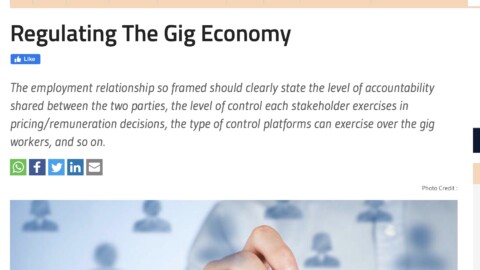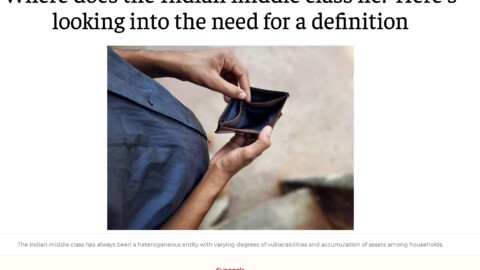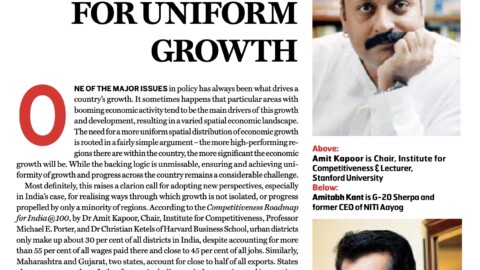By Amit Kapoor with contributions from Shivani Kowadker
The term ‘welfare’ in economics has a long history, with different schools of thought defining the term in different ways. The modern usage of the term typically associates it with a system wherein the government bears a major responsibility for providing socio-economic security to citizens. Over the years, the term has also attracted criticism, as critics have associated it with excessive or unnecessary government intervention. This has led to questions about the extent to which the state should be involved in the welfare system. A limited definition of welfare has often associated it with provision of social safety nets, poverty alleviation programs, social insurance and government intervention. While these are significant goals, the plethora of challenges we face today necessitates a new way of looking at what welfare constitutes—a change long overdue. Economist Nicholas Barr underscores the centrality of the welfare state and the need to redesign it to make it fit for purpose given the ever-evolving social and economic circumstances. The question that needs to be raised is: Does an age-old concept of welfare in times that are drastically different and ever-changing, really allow people to fare well? The idea of welfare needs to go beyond providing a mere buffer during tough times. The goal is not just to provide safety nets, but to create conditions that make citizens not require safety nets in the first place. The latter is the real task. The task of reimagining welfare is precisely to emphasize the latter. India is going through interesting times. Its people have demonstrated a desire for change. In this context of redefining welfare, how and what should the Indian state change? What then should state and local governments focus on?
Investing in human capital amplifies welfare efforts by making individuals able citizens, reducing dependency and enhancing overall societal well-being. The very foundation of welfare and overall being lies in the areas of education, skilling and health. According to the World Bank estimates, each additional year of education leads to an increase of about 10 percent in annual earnings for an individual. The intrinsic value of education and its economic benefits are apparent advantages; however, a revamped Indian state must strategize to tackle learning crisis among students and equip learners with a skill-set fit for today’s world – one that comprises analytical, cognitive, mental, and digital skills. Climate change and AI are examples of future changes that we already recognize. Many similar changes will reshape economies and societies, making job creation a dynamic process with newer segments transforming where we work and how we work. Beyond skilling, health is another core component of a welfare system. India still lags behind on a range of health-related parameters. While the share of Out-of-Pocket Expenditure (OOPE) in Total Health Expenditure has reduced from around 62 percent in 2014 to 47 percent in 2019, it still shows that citizens bear a colossal burden of healthcare costs. A substantial increase in public investment in quality healthcare in India is central to a new Indian welfare system.
The pandemic was a jolt to our lives and livelihoods in more ways than one. It showed us the significance of building resilience to unpredictable external events. In a redesigned welfare system in India, formulating strategies to build resilience to the impact of climate change, and adaptability to technological innovations and demographic shifts should be a focus area. The effects of climate are already being felt, and without necessary action, the effects will only be further aggravated. According to World Bank, over 80 percent of India’s people reside in districts that are prone to climate-induced disasters. Estimates also suggest that productivity decline due to heat stress may lead to job losses for around 34 million people in India. A renewed welfare system in India should accelerate progress towards climate-resilient development through a focus on mitigation as well as adaptation. It is time to strategize and implement measures to assist those affected by and prone to climate-related disasters. This will take a multi-pronged approach across multiple sectors including transport, agriculture, health, energy and infrastructure.
For efforts across the board to come to fruition and be reflected in the form of concrete outcomes and growth, revamping India’s administration for a more agile state is of the essence. In order to see tangible outcomes of any welfare-oriented measures, bringing in efficiency in our administrative processes is akin to strengthening the country’s backbone. As India steps into a new term, let’s remind ourselves of an issue that has been a persistent source of concern and complain for a long time – lack of effective last-mile delivery of various welfare schemes. On paper, 73rd and 74th Constitution Amendment Acts mark a watershed event, establishing local self-governance in rural and urban India fostering greater participation in governance. However, to what extent are local governance bodies and functionaries empowered? This issue bears relevance to India’s oft-discussed implementation challenge. The third-tier is the first and the closest layer of interaction between people and the government. Grassroots democracy thrives at the third-tier of governance. To understand what hinders local bodies from functioning efficiently, the Comptroller and Auditor General of India (CAG) is working alongside state governments in conducting audit exercises across local bodies to enhance governance, utilisation of funds and service delivery. Yet another aspect that warrants attention and discussion is the ramifications of competitive welfare strategies undertaken for the purpose of gaining favour for elections. An election-driven policy, in its pursuit of gaining voter appeal and favour, often tends to be short-term and unsustainable. Welfare issues are complex. They require long-term planning and holistic thinking. A poorly thought-out welfare policy may be unfeasible both implementation-wise and fiscally as well. It is important to think about the fiscal costs we may incur due to unsustainable and ill-conceived competitive welfare programmes. While they may seem beneficial for a certain voter base in the short-term, haphazard programmes tend to be detrimental in the long run. In addition to all our efforts to develop and grow across various sectors, reforming bureaucracy serves as the vital adhesive that binds our initiatives together, ensuring efficiency, transparency, and sustainability in our progress. Efficient and streamlined bureaucratic processes form the bedrock for our future advancements.
The article was published with Mint on July 17, 2024. The article was part of the special issue on “How to Pack for the Journey to 2047” by Mint.
























